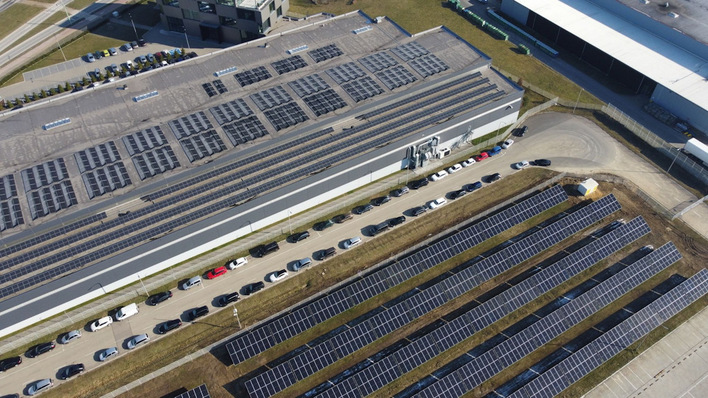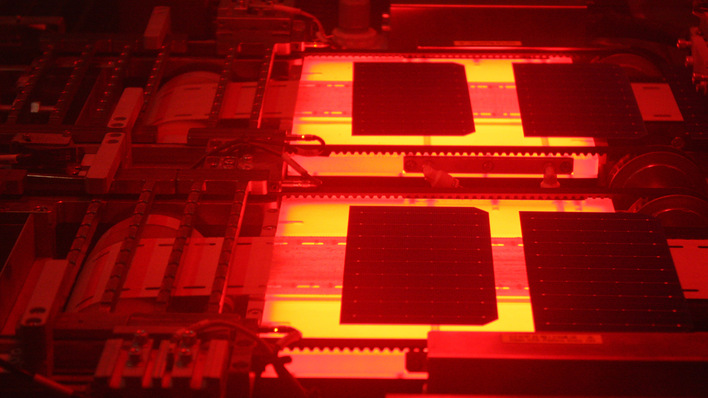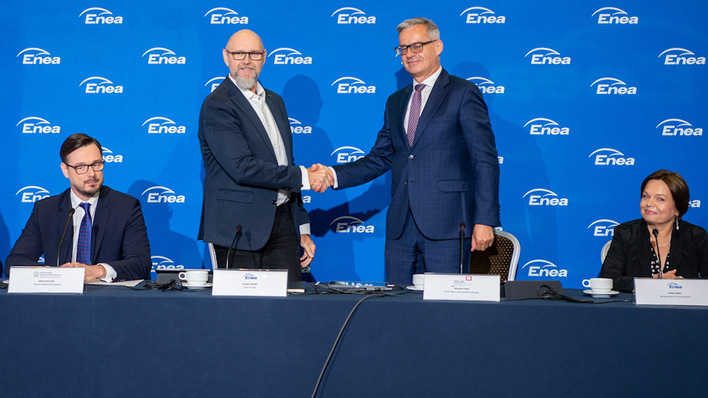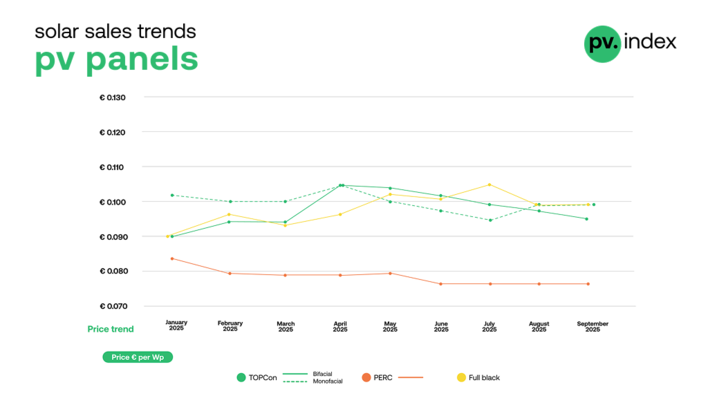- Functions of the power electronics for solar generators
- Solar inverters for rooftop generators
- Central inverters for large-scale solar parks
- String inverters vs. substations?
- Wiring of solar facades
- DC Optimisers for solar panels
- Inverter dwarfs for individual solar panels (AC panels)
And here are the further explanations:
1.Functions of the power electronics for solar generators
Solar panels produce direct current voltage, and if connected to an electric circuit, they generate direct current (DC). For most devices and machines, direct current is not useful because they are designed to run on alternating current (AC). The power grids also run on alternating current. Converting direct current into grid-compatible alternating current is what inverters are for. They have the following functions:
-Adjusting the voltage of 1,000 or 1,500 volts from the solar strings down to the (AC) grid voltage: European low-voltage grids run on a standard 220 volts (for single-phase power grids) or 400 volts (three-phase grids). In the US, Japan and various other countries it is 110 volts.
-Depending on the size of the solar generator, inverters can also feed into the grid at medium-voltage (from one up to 40 kilovolts). The higher the grid voltage, the larger the transformer adjusting the AC voltage from the inverter needs to be. There also are solar parks that feed in at high voltage (over 110 kilovolts) using large-scale inverters and substations.
- Adjusting the frequency of the alternating current to that of the grid (synchronisation): 50 hertz is the standard in Europe, 60 hertz in the US and Japan.
-Optimising the solar yields from the panel strings by what is known as Maximum Power Point Tracking (MPPT). This involves always keeping the I-V curve of the solar voltage and the currents in the solar panels at maximum power and thus at maximum yield. For every connected panel string, the inverter has a separate MPP tracker.
- Controlling the solar generator in case of an instability in the grid: Solar installations can assist in stabilising unstable power grids. If there is too much electricity in the grid (driving up voltage and frequency), the installation is taken offline. If the voltage or frequency is too weak, the solar generator feeds in at full capacity. If combined with a large storage battery, this grid-stabilising effect can be utilised to an even greater degree.
-Inverters also take on the task of switching if the power grid suffers a short- or long-term break down. In combination with a storage battery, the solar generator can function as an uninterruptable power supply. That is important for commercial and industrial applications as well as in areas that are often effected by storms, flooding or other natural disasters.
- Together with a storage battery the inverter can optimise the self-consumption of solar energy, so that only the surplus electricity is fed back into the grid. Or it controls a self-sufficient mini-grid which works fully independent of the public power grid.
-Further, smart inverters allow directly using the DC from the solar generator to charge batteries (storage) or electric vehicles.
-Inverters also include important functions for the technical protection of the solar installation (safeguarding against voltage surges, lightning, electric arcs as well as disconnecting in case of fire). Regulations may vary between countries. (back to top)
2. Solar inverters for rooftop generators
Since shading tends to be less of an issue that way, solar generators are generally mounted on roofs. Such rooftop installations are usually connected through string inverters, where a certain number of solar panels are combined to form a ring of panels (string) which is in turn connected to the DC input of the inverter. The DC voltage of the panel string usually does not exceed 1,000 volts. For large-scale rooftop installations on industrial buildings, up to 1,500 volts are possible. Small string inverters (up to ten kilowatts AC output) are usually optimised for self-consumption of the solar electricity. They can incorporate a storage battery. Larger string inverters have more than one MPP tracker and are configured strictly for feed-in installations. Few such units are pre-configured for storage batteries. Small string inverters can work without an internal transformer, whereas larger ones require so-called galvanic isolation, i.e. they have a built-in transformer to handle the connection to the grid. String inverters need to be installed by trained electricians, such as also do household electrics. These technicians are usually also qualified to install storage batteries and charge points for electric cars. (back to top)

This new single phase transformerless solar inverter from Delta Energy Systems.
3. Central inverters for large-scale solar parks
In the case of industry- or utility-scale solar parks, very high-performance central inverters are used which convert DC voltages of up to 1,500 volts and strong currents coming from the solar array. They are designed to feed the high-power (DC) output from the power plant into the (AC) grid with as little loss as possible. So they also produce a higher voltage on the AC side than string inverters. Planning, installing and monitoring such substations should be left to qualified engineers, which is also why they count as power plant rather than domestic technology. (back to top)
4. String inverters vs. substations?
Due to price pressure, it has become common practice to also use string inverters to connect smaller solar parks generating only a few megawatts. This has the advantage that it is easier and quicker to exchange damaged or faulty units. Also, the DC wiring for the panel arrays is more simple. Coper is expensive and every metre saved counts. For that reason, at least for solar parks up to 50 megawatts, it can be worthwhile to estimate and compare both models. (back to top)
5. Wiring of solar facades
A special application in photovoltaics are solar facades. They involve the integration of solar panels for electricity generation in the side of a building. Facades often are (at least partially) shaded. Also, the position of the sun has different effects on such vertically mounted solar panels than it would have on a rooftop array. Furthermore, there often is very little or no space behind the facade for mounting an inverter, and later it can become difficult to access the back of the panels for maintenance of the electrical components.
For that reason, special small inverters are used for solar facades which connect two panels in parallel rather than many panels in one serial string. This keeps the DC voltage fairly low, thus strongly reducing the risk of voltage surges or electrical arcs near the panels. It also makes sense to use so-called DC optimisers or panel inverters. Connecting solar facades to conventional string inverters is usually not possible. Because of the wiring of the panels, it is necessary to consult a competent specialist when planning a solar facade. (back to top)
6. DC Optimisers for solar panels
Another neat idea: Rather than planning the power electronics as serial panel strings, do it for each solar panel individually. This keeps the voltages and currents much lower and more manageable. For instance, putting the power converters close to the panels makes it possible to optimise the yields from individual solar panels or from two connected ones, which can produce up to 30 percent more capacity. Because the panels are no longer connected as strings, negative effects from shading, manufacturing tolerances or the different orientation of the solar panels can be dealt with much better. Solar facades are often very fragmented or a rooftop generator consists of small, isolated or different panels. In that case, the DC optimisers convert the DC voltage from the panels to a specific value. All optimisers are then connected in a string, which in turn is hooked up to the inverter. All it still does is the DC-AC conversion. MPP tracking or safety electronics are integrated within the thin DC optimiser. So-called smart panels already have the DC electronics included as part of the panel connector. Utilising DC optimisers considerably reduces the planning effort in the case of challenging roofs or solar facades. If they get disconnected from the inverter, each panel is immediately switched off. This significantly increases the safety of the installation in case of accidents or damage. (back to top)

Suppliers of modular sockets have already prepared these components for intelligent electronics, both for 1,000 volts and for 1,500 volts.
7. Inverter dwarfs for individual solar panels (AC panels)
It would be even more consistent to have the AC conversion happen directly by the solar panel. This is known as panel inverters which produce alternating current. Some experts call them AC panels. The downside is their high cost. AC conversion is the most expensive component of the power electronics and having it at each panel increases the necessary investment compared to string installations or DC optimisers. Also, the panels produce 220 volts AC, compared to the 31.5 volts of a DC optimiser. There is a greater risk of a dangerous electric shock in case faulty wiring. And: Alternating current does not work well with lead or lithium storage batteries, which are charged up by direct current.
The advantages: None of the DC wiring is necessary, as the solar panels can directly supply AC power to the consumers. The alternating current from the solar panels is collected in a ring circuit. However, before it can be connected to the grid, it needs to be synchronised to the grid frequency, usually through small control units. (back to top)
(HS/HCN)
To get deeper into business, read this:
Solar inverters: our insight stories at a glance
Solar inverters: our expert’s interviews at a glance
Solar power electronics: costs, prices and finance at a glance
Solar power electronics for commercial use: all reports at a glance








